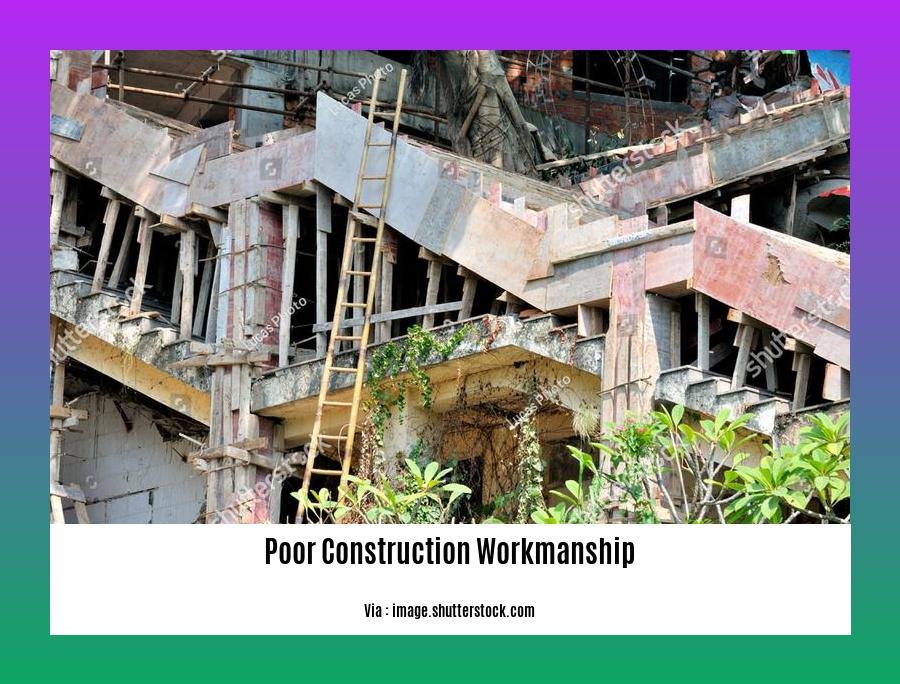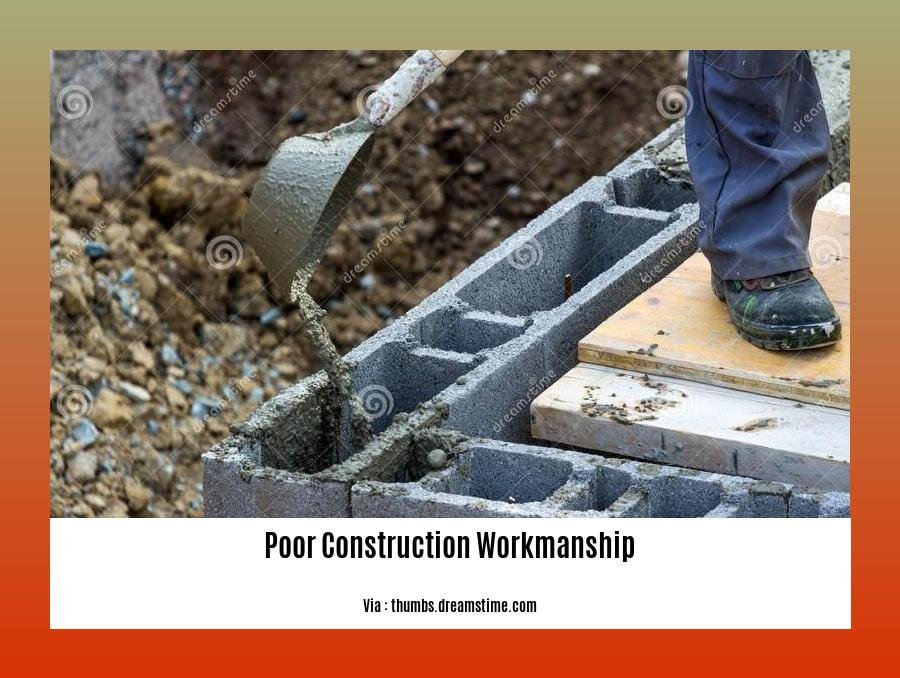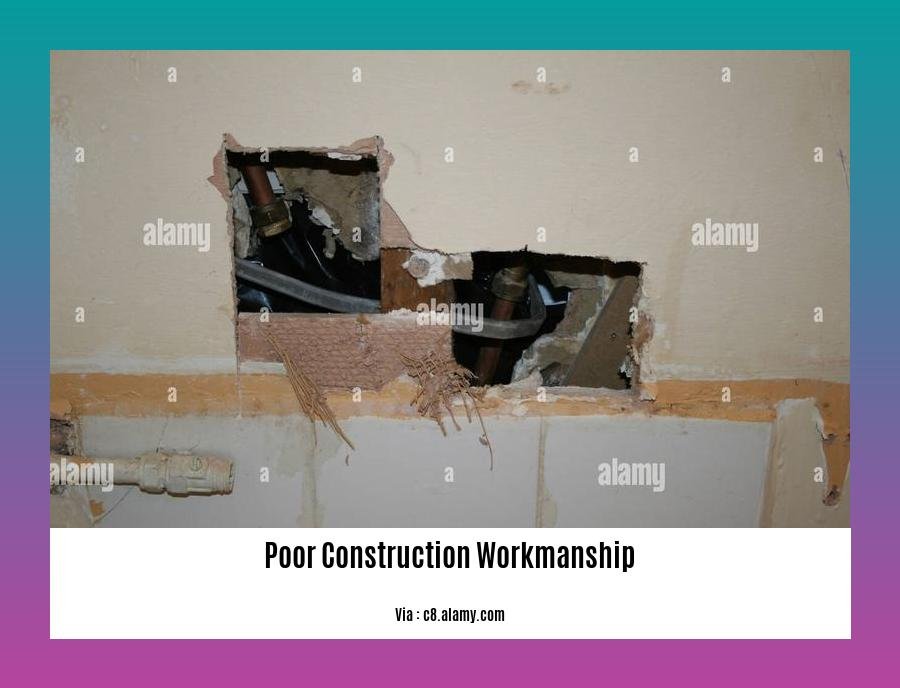[- The Perils of Poor Construction Workmanship: A Guide to Identifying and Mitigating Defects] – Substandard construction workmanship can pose significant hazards to buildings and their occupants, leading to structural instability, health risks, and diminished property value. Recognizing the warning signs of faulty construction is crucial for property owners, contractors, and inspectors alike. This comprehensive guide will equip you with the knowledge to identify and address construction defects effectively, ensuring the safety and integrity of your building.
Key Takeaways:
- Poor construction workmanship stems from non-compliance with industry standards, documents, and instructions.
- Examples of poor workmanship include incorrect product installation, improper cement mixtures, flawed plumbing, and inadequate concrete compaction.
- Sources:
Poor Construction Workmanship: Identification and Prevention

What is Poor Construction Workmanship?
Poor construction is the failure to adhere to industry standards and building codes in construction projects. This can result in structural issues, safety hazards, and diminished property value.
Examples of Poor Construction Workmanship:
- Installing materials incorrectly
- Using incorrect proportions in concrete
- Faulty plumbing systems
- Inadequate compaction of soil or concrete
Consequences of Poor Construction Workmanship:
- Structural damage
- Building code violations
- Safety risks to occupants
- Reduced property value
- Increased maintenance and repair costs
Identifying Poor Construction Workmanship:
- Check for cracked foundations or walls
- Observe sagging or uneven floors
- Examine plumbing for leaks or drainage issues
- Look for water damage on ceilings or walls
- Inspect electrical systems for overloading or loose connections
Preventing Poor Construction Workmanship:
- Hire licensed and experienced contractors
- Review construction plans thoroughly
- Ensure that materials meet industry standards
- Conduct regular inspections throughout construction
- Request warranties and guarantees for materials and labor
Tips for Mitigating Poor Construction Workmanship:
- Document all issues with photos and documentation
- Contact the contractor immediately to address the defects
- Consider hiring an independent inspector for a second opinion
- File a complaint with the appropriate regulatory agency if necessary
- Seek legal advice if necessary
By following these steps, you can identify and mitigate poor construction issues, ensuring that your building is safe, reliable, and of the highest quality.
- Do you require a cost estimation for a polyhouse? Explore our article on polyhouse construction cost to gain valuable insights.
- Trying to connect with reliable construction companies in Port Elizabeth? Look no further. Check out our comprehensive list of port elizabeth construction companies.
- To maintain hygiene at your construction site, consider using a portable toilet. Read more about portable toilet construction site for details.
- For educators seeking guidance on curriculum design, our resource on principles of curriculum construction b ed notes is a must-read.
- Creating an effective timetable is crucial for a smooth operation. Discover the principles of time table construction in our informative guide.
Best Practices for Ensuring Quality Construction

Key Pillars:
- Establishing clear quality workflows
- Conducting frequent risk assessments
- Standardizing processes
- Benchmarking performance
Maintaining Quality Standards
Shoddy construction is a widespread problem that has serious safety, financial, and aesthetic consequences. To avoid these, it’s crucial to implement and follow best practices throughout the construction process.
Best Practices for Ensuring Quality Construction
1. Establish Clear Quality Workflows
Define quality control procedures from the project’s onset. These should include inspections, testing, and documentation. Assign responsibilities clearly and ensure everyone understands their role in maintaining quality.
2. Conduct Frequent Risk Assessments
Identify potential issues that could impact construction quality, such as design flaws, material defects, or施工errors. Develop mitigation plans to address these risks proactively.
3. Standardize Processes
Ensure consistency in construction methods and materials. This helps minimize defects and maintain quality. Use standardized templates, checklists, and specifications to guide construction activities.
4. Benchmark Performance
Compare construction processes to industry standards. Identify areas for improvement and implement measures to enhance quality. Regularly monitor and evaluate performance to ensure continuous improvement.
5. Empower Workforce
Engage the workforce in quality control efforts. Provide training, tools, and resources to enable them to identify and address quality issues. Foster a culture of accountability and pride in craftsmanship.
6. Ensure Traceability
Document all construction activities, including inspections, testing, and materials used. Keep records organized and easily accessible. This helps with quality control and troubleshooting issues.
Benefits of Quality Construction:
- Increased safety and durability
- Reduced maintenance costs
- Improved property value
- Enhanced occupant satisfaction
- Reduced liability risks
Citation Hotspots
- Construction Quality Management 101
- 10 Steps to Ensure Quality on Construction Projects
Legal Implications and Liabilities
Navigating the Legal Landscape of Construction Workmanship
When construction workmanship falls short, the consequences can extend beyond structural flaws and aesthetic imperfections. Legal implications and liabilities come into play, potentially resulting in costly lawsuits, reputational damage, and even criminal charges.
Key Responsibilities and Obligations
Contractors and construction professionals have a legal obligation to ensure their work meets building codes and industry standards. They are responsible for:
- Adhering to contract specifications and plans
- Utilizing proper materials and equipment
- Employing skilled workers
- Complying with safety regulations
Consequences of Negligence
Negligence in construction can result in a breach of contract, leading to:
- Payment disputes
- Claims for damages
- Injunctions to halt construction
- Loss of license or certification
More severe cases of negligence can constitute gross negligence, triggering:
- Civil liability: Monetary damages, including compensation for injuries, property damage, and lost profits
- Criminal liability: Fines, imprisonment, or both
Protecting Yourself
To mitigate legal risks and liabilities, consider these steps:
- Maintain Records: Document all aspects of the project, including contracts, plans, inspection reports, and communications.
- Hire Qualified Professionals: Contract with licensed, reputable contractors and sub-contractors.
- Obtain Inspections: Conduct regular inspections with independent third-parties to verify workmanship quality.
- Secure Insurance: Coverage against lawsuits and damages is crucial.
- Seek Legal Advice: If disputes arise, it is advisable to consult with an attorney specializing in construction law.
Key Takeaways:
- Construction professionals are legally obligated to meet building codes and standards.
- Negligence in workmanship can lead to civil and criminal liabilities.
- Documenting the project and hiring qualified professionals can mitigate risks.
- Inspections and insurance provide additional protection.
- Seeking legal advice is essential when disputes arise.
Citations:
- Legal Liability in Construction
- Construction Law: Legal Responsibilities of Contractors and Subcontractors
Homeowner Protection and Recourse: Safeguarding Your Construction Investment
Key Points:
- Document Issues Thoroughly: Capture evidence of defects with photos, videos, and detailed descriptions.
- Communicate with the Contractor: Clearly express your concerns and provide a reasonable time frame for resolution.
- Seek Professional Support: Consult with an independent inspector or structural engineer for an unbiased assessment.
- Explore Legal Options: Consider filing a complaint with the contractor’s licensing board or pursuing legal action if necessary.
- Protect Yourself Financially: Pursue compensation for damages, repairs, or project completion costs.
Steps to Take:
- Document the Defects: Gather evidence of the workmanship issues, including photographs, videos, and written descriptions.
- Contact the Contractor: Inform the contractor about the problems and request a prompt resolution within a specified time frame.
- Obtain a Professional Assessment: Hire an independent inspector or structural engineer to verify the extent of the defects.
- Explore Legal Options: If the contractor fails to resolve the issues, consider filing a complaint with the licensing board or seeking legal assistance.
- Protect Your Finances: Calculate the cost of repairs or project completion and pursue compensation through insurance, legal action, or a home warranty.
Remember:
- Thorough documentation is crucial for protecting your rights.
- Open communication with the contractor can often lead to a mutually acceptable solution.
- Professional assessments provide unbiased evidence of workmanship issues.
- Legal options are available if other measures fail to resolve the situation.
- Don’t hesitate to seek professional help and explore all avenues of Homeowner Protection and Recourse to safeguard your construction investment.
Relevant URL Sources:
- National Association of Home Builders: Homeowner Warranty Guide
- American Bar Association: Homeowner Protection Guide
FAQ
Q1: What are some common examples of poor construction workmanship?
Q2: What are the potential consequences of poor construction workmanship?
Q3: What steps can be taken to mitigate the risks of poor construction workmanship?
Q4: What are the responsibilities of construction professionals in ensuring quality workmanship?
Q5: What options are available to homeowners who experience issues with poor construction workmanship?
- Grass Forever in Livermore: Your Guide to Artificial Turf - April 22, 2025
- German Roaches vs. American Roaches: Key Differences and Control - April 22, 2025
- 150+ Flowers That Start With S: A Comprehensive Guide - April 22, 2025










